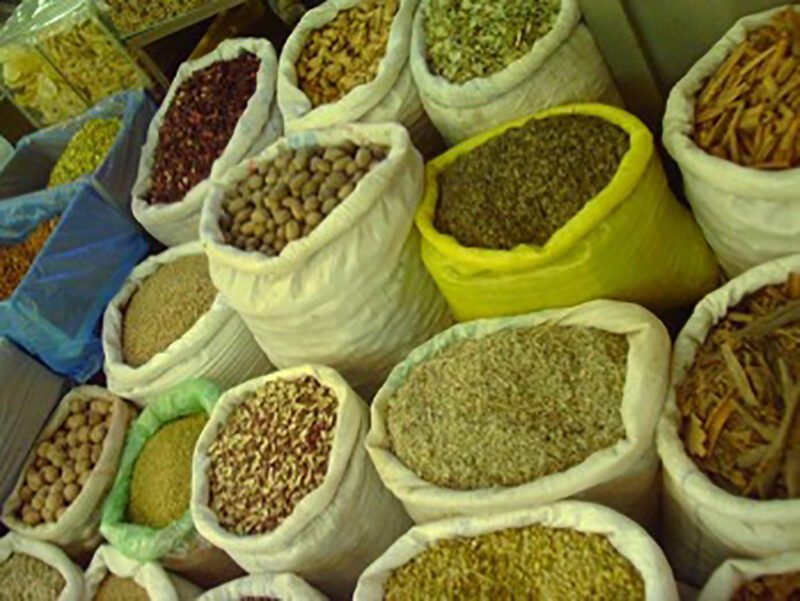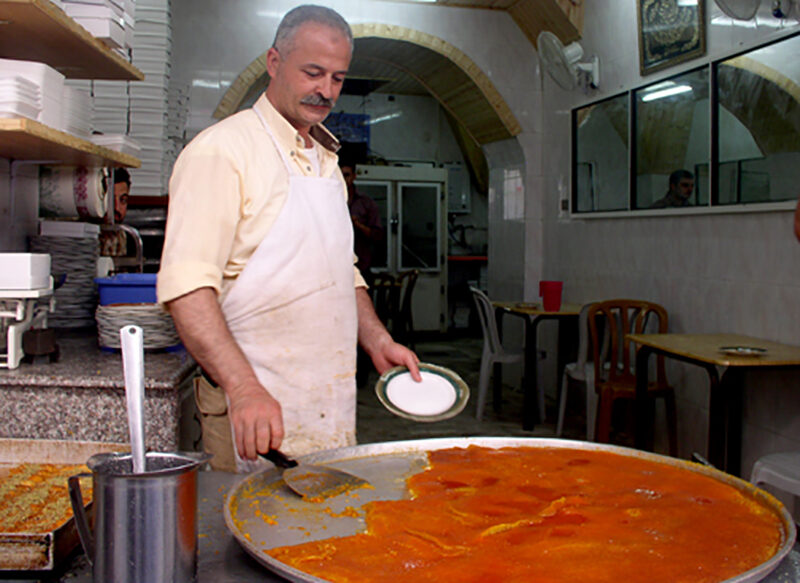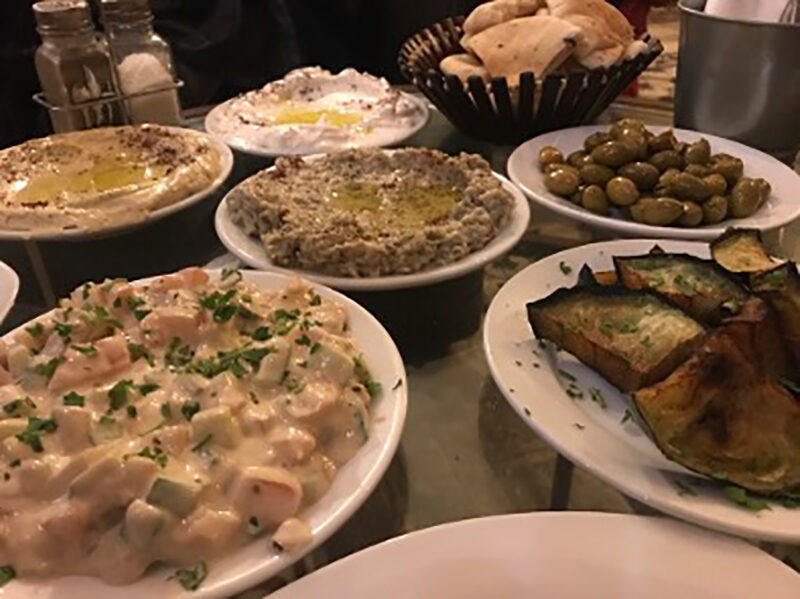
Palestine
Food Culture
In any culture, social relations, rituals and exchange all take place surrounding food and sharing meals with others. Over years of living in Palestine I have participated in numerous shared meals in many communities as displays of hospitality, many of the most simple and traditional have involved eating with hand. With flat bread, pita pan, as the staple of diet in most of the Arab Levant, food is usually consumed either directly by hand or using the bread to dip, hold and manipulate various ingredients. Picnics, barbeques and simple everyday meals usually consist of a stack of bread accompanied by some salads and dips such and hummus, tabooli, and similar dished while za’tar, pastries and olives might be served on the side. Almost all simple dishes which are usually eaten directly using small pieces of bread torn by hand, whereas more sophisticated meals might be consumed with fork and spoon, although there are variations depending on the area and history.

Indigenous (baladi[*1]) foods such as olives, za’tar and figs not only constitute traditional and easy to grow staples, but are also highly symbolic in terms of cultural and family heritage. Olive trees in particular are often passed through many generations. Vegetables, fruits and herbs that are considered baladi are preferable to imported seeds or foods for planting and consumption.[*2] In Palestinian villages it was common for every family to have their own specific recipes for herb and spice mixtures such as za’tar. Traditionally, foods such as wild cauliflower and thyme for za’tar would be gathered from mountaintops by villagers and brought to towns and markets, but due to the harsh restrictions on movement, imported species must be purchased at markets. Most Palestinians consider baladi plants to have a stronger flavour more appropriate for Arabic cooking.

Palestinian identity has become politicized since the Nakba and the creation of Israel in 1948 and the displacement of hundreds of thousands of Palestinians as refugees across the Middle East. Indeed the ‘refugee experience’ came to characterize a unique shared identity and nationalist consciousness among a diverse population dispersed in different situations, and in the absence of a nation. Nevertheless a distinctly unique Palestinian identity existed predating the collective antagonism of colonial displacement, an identity built on the diverse historical interactions and coexistence between many cultures. Salim Tamari has examined the historical records of interactions between the merchants and artisans residing in the coastal cities along the Mediterranean, and the famers and living in the mountainous regions of the West Bank and Jordan Valley.[*3] While there existed a historical distinction between the mountain and the sea, trade routes and rapid economic growth brought the populations closer together and as well as influencing diversified food cultures. British rule under the mandate system established after the fall of the Ottoman Empire further influenced dinning behaviors, particularly among the urban elite.
Prior to 1967 and the Israeli occupation of the West Bank and Gaza, the Palestinian agricultural sector was roughly equal to the Israeli agricultural sector, and Palestinians exported approximately 80 per cent of the produce grown in the West Bank.[*4] Tamari notes that in 1968, half of the total Palestinian labour force worked in the agriculture sector; by 1978, this was greatly reduced as nearly one third of the labour force worked inside Israel.[*5]

Agriculture is closely linked with Palestinian cultural identity as well as providing a majority of the income for rural communities. As lands, homes and olive groves have been passed from one generation to another, villages, agriculture and the idea of community constitute an important place in local identity. The notion of fellah or peasant is deeply rooted in the Palestinian narrative as an agricultural pastoral society.[*6] As communities have been divided, conceptions of identity and belonging have been severed from the larger community. Individuals reappropriate inherited memories in order to make sense of the present.[*7] The constructed imagery of the Palestinian peasant and the village as the territorial manifestation of cultural identity produced a unifying effect among Palestinians in different situations. The long-term division of different Palestinian communities has caused individuals to reformulate their sense of collective identity based on their isolated circumstances. The isolation of Palestinian communities from other segments of society and disruptions in such basic processes as acquiring, sharing and preparing food has altered the ways in which different communities work for survival, and the ways that their residents articulate their own senses of collective identity.[*8]

While eating behaviours in urban settings have adapted to the extent that forks and knives are common place, many staple dishes are more commonly consumed by hand. In rural villages where food is traditionally produced, meals are frequently shared in a simple setting of shared dishes arranged on a cloth on the floor and consumed directly by hand using only bread to hold the food. Utensils will be used for more sophisticated meals, remote villages and Bedouin communities which are often isolated from infrastructure and experience higher rates of poverty, frequently display more traditional eating behaviours. While ingredients and eating practices vary drastically from one culture to another, the social importance of sharing food is a foundation within any culture. Many indigenous cultures in South Asia view using utensils to stab and cut food or even chopsticks to manipulate food, to be barbaric as they distance the food from the person consuming it. Practices of sharing meals and eating-with-hand continue in Palestinian communities connecting people to once another as well as solidifying an intimate connection between people and their food heritage.


Post script for eating with hands
- Posture: No rule, people sit as they are comfortable.
- Contraindications on the left and right hand: No rule.
- Relation to Religion: Just custom, not religion.
- Dishes setting: Usually each food (hummus, salad, pickle, etc) is on their own shared plates and people take from that plate just using torn bread or hand. People might have their own plate but not always.

- Baladi ([of] my country) is used to describe plants indigenous to Palestine.
- Rickard, J. (2013) “The Secret Gardens of Nablus: community and food security under occupation.” Middle East Perspectives series vol. 1. MEI. National University of Singapore
- Tamari, Salim. Mountain against the sea: Essays on Palestinian society and culture. Univ of California Press, 2008.
- Applied Research Institute of Jerusalem (ARIJ), A Review of the Palestinian Agricultural Sector (2007). Available from www.arij.org/files/admin/2007_agricutlure_sector_review_arabic_lr.pdf.
- Tamari, Salim, Building Other People’s Homes: The Palestinian Peasant’s Household and Work in Israel (Berkeley, CA: University of California Press, 1981), pp. 33–7.
- Mauro van Aken, ‘Facing home: Palestinian belonging in a valley of doubt’, PhD dissertation, Faculteit Sociale Wetenschappen, Universiteit Utrecht, 25 November 2003, p. 88.
- Lybarger, Loren, Identity and Religion in Palestine: The Struggle between Islamism and Secularism in the Occupied Territories (Princeton, NJ: Princeton University Press, 2007), p. 16.
- Rickard, J. (2022). The Fragmentation of Palestine: Identity and Isolation since the Second Intifada. I.B. Tauris-Bloomsbury PLC. London, New York.
Profile

Joshua Rickard
A photographer and social anthropologist currently based in Kumamoto, Japan. He has been working in Palestinian communities since 2007 and recently published The Fragmentation of Palestine with I.B. Tauris-Bloomsbury.





Leave a
Comment